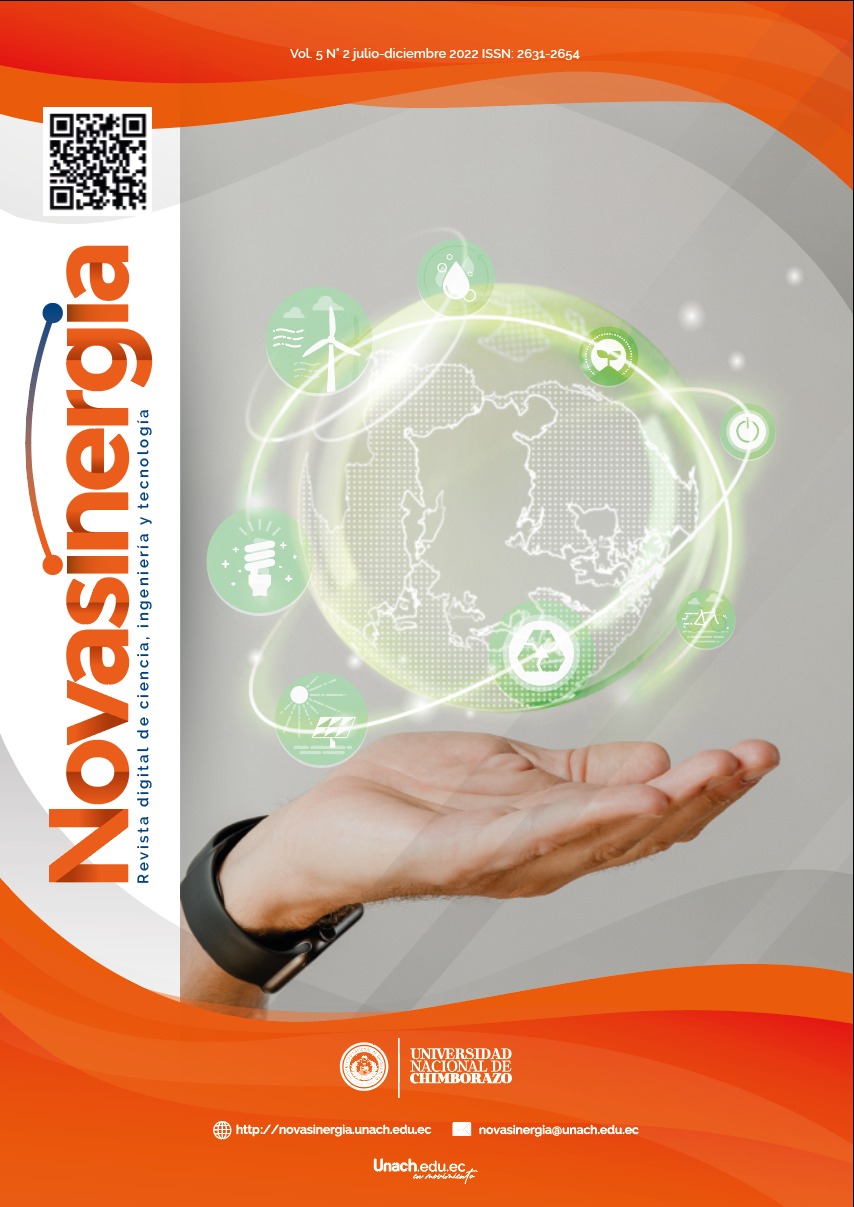Influence of geomorphology and flow on the water quality of Guano river, Ecuador
DOI:
https://doi.org/10.37135/ns.01.10.10Keywords:
Flow, geomorfología, solpe , water quality, WQIAbstract
The present study determines the water quality of the Guano River in Ecuador through the water quality indices WQI-NSF, WQI-Dinius, and a variant of the WQI-Dinius index that includes the average slope of the riverbed and the flow. To obtain qualitative values of water quality that allow better use of the river water. The results obtained with the three indices show that there is slight contamination in river sections caused by human activities, decreased flow, and wastewater discharge. Furthermore, the work shows that when applying the WQI-Dinius modified, the values of the weights of the water quality are lower concerning the other indices. But, even when the WQI-Dinius modified values are common, the valuation range for agricultural use is similar among the three indices, maintaining the criterion that the Guano River is slightly contaminated. Therefore, treating the water before using it in agricultural activities is necessary.
Downloads
References
Akhtar, N., Ishak, M. I. S., Ahmad, M. I., Umar, K., Md Yusuff, M. S., Anees, M. T., … Almanasir, Y. K. A. (2021). Modification of the Water Quality Index (WQI) Process for Simple Calculation Using the Multi-Criteria Decision-Making (MCDM) Method: A Review. Water, 13(7), 905. https://doi.org/10.3390/W13070905
Bitsch, B., Raymond, S. N., Buchhave, L. A., Bello-Arufe, A., Rathcke, A. D., & Schneider, A. D. (2021). Dry or water world? How the water contents of inner sub-Neptunes constrain giant planet formation and the location of the water ice line. Astronomy & Astrophysics, 649, L5. https://doi.org/10.1051/0004-6361/202140793
Castillejos, P., & Arévalo, P. (2018). Diatomeas epilíticas como bioindicadoras de eutrofización en la microcuenca del río “Guano”, provincia de Chimborazo (Trabajo para obtener el título de Máster en Gestión Ambiental). Quito:Ecuador. Universidad Internacional SEK. Retrieved from http://link.springer.com/10.1007/978-3-319-59379-1%0Ahttp://dx.doi.org/10.1016/B978-0-12-420070-8.00002-7%0Ahttp://dx.doi.org/10.1016/j.ab.2015.03.024%0Ahttps://doi.org/10.1080/07352689.2018.1441103%0Ahttp://www.chile.bmw-motorrad.cl/sync/showroom/lam/es/
Castillo-López, G., Salas-Cisneros, P., Logroño-Veloz, M. A., & Vinueza-Veloz, M. F. (2021). Hexavalent Chromium in Waters for Human Consumption and Irrigation in the Guano Canton. ESPOCH Congresses: The Ecuadorian Journal of S.T.E.A.M., 524–532. https://doi.org/10.18502/ESPOCH.V1I1.9592
Cevallos, C. (2015). Caracterización de la calidad hídrica de la Microcuenca del río Guano (Trabajo final de titulación), Riobamba:Ecuador, Escuela Superior Politécnica de Chimborazo. Retrieved from http://dspace.espoch.edu.ec/handle/123456789/4061
Chidichimo, F., Mendoza, B. T., De Biase, M., Catelan, P., Straface, S., & Di Gregorio, S. (2018). Hydrogeological modeling of the groundwater recharge feeding the Chambo aquifer, Ecuador. AIP Conference Proceedings, 2022(1), 020003. https://doi.org/10.1063/1.5060683
Davids, J. C., Rutten, M. M., Pandey, A., Devkota, N., David Van Oyen, W., Prajapati, R., & Van De Giesen, N. (2019). Citizen science flow-an assessment of simple streamflow measurement methods. Hydrology and Earth System Sciences, 23(2), 1045–1065. https://doi.org/10.5194/HESS-23-1045-2019
Gradilla-Hernández, M. S., de Anda, J., Garcia-Gonzalez, A., Montes, C. Y., Barrios-Piña, H., Ruiz-Palomino, P., & Díaz-Vázquez, D. (2020). Assessment of the water quality of a subtropical lake using the NSF-WQI and a newly proposed ecosystem specific water quality index. Environmental Monitoring and Assessment, 192(5), 1–19. https://doi.org/10.1007/S10661-020-08265-7
Gupta, S., & Gupta, S. K. (2021). A critical review on water quality index tool: Genesis, evolution and future directions. Ecological Informatics, 63, 101299. https://doi.org/10.1016/J.ECOINF.2021.101299
Hoseinzadeh, E., Khorsandi, H., Wei, C., & Alipour, M. (2015). Evaluation of Aydughmush River water quality using the National Sanitation Foundation Water Quality Index (NSFWQI), River Pollution Index (RPI), and Forestry Water Quality Index (FWQI). Desalination and Water Treatment, 54(11), 2994–3002. https://doi.org/10.1080/19443994.2014.913206
Machado, A. V. M., dos Santos, J. A. N., Alves, L. M. C., & Quindeler, N. da S. (2019). Contributions of Organizational Levels in Community Management Models of Water Supply in Rural Communities: Cases from Brazil and Ecuador. Water, 11(3), 537. https://doi.org/10.3390/W11030537
Marimón-Bolívar, W., Jiménez, C., Toussaint-Jiménez, N., & Domínguez, E. (2021). Use of Neural Networks to Estimate a Global Self-Purification Capacity Index for Mountain Rivers: A Case Study in Bogota River Basin. Earth Systems and Environment 2021, 1–13. https://doi.org/10.1007/S41748-021-00248-Z
Mendoza, B., Fiallos, M., Iturralde, S., Santillán, P., Guananga, N., Bejar, J., … Sándor, Z. (2021). Determination of field capacity in the Chibunga and Guano rivers micro-basins. F1000Research, 10. https://doi.org/10.12688/F1000RESEARCH.28143.1
Moreano-Logroño, J. A., & Mancheno-Herrera, C. A. (2020). Analysis of the productivity and competitiveness of the agricultural sector in Ecuador. Dominio de las Ciencias, 6(5), 412–428. https://www.dominiodelasciencias.com/ojs/index.php/es/article/download/1610/3073
Mukate, S., Wagh, V., Panaskar, D., Jacobs, J. A., & Sawant, A. (2019). Development of new integrated water quality index (IWQI) model to evaluate the drinking suitability of water. Ecological Indicators, 101, 348–354. https://doi.org/10.1016/J.ECOLIND.2019.01.034
Nong, X., Shao, D., Zhong, H., & Liang, J. (2020). Evaluation of water quality in the South-to-North Water Diversion Project of China using the water quality index (WQI) method. Water Research, 178, 115781. https://doi.org/10.1016/J.WATRES.2020.115781
Nugraha, W. D., Cahyo, M. R. D., & Hardyanti, N. (2020). The Influence of Land Use To River Water Quality Level by Using The Water Quality Index Of National Sanitation Foundation (WQI-NSF) Method (Case Study: Klampok River, Semarang District). In The 5th International Conference on Energy, Environmental and Information System (ICENIS). E3S Web of Conferences, 202, 04006. https://doi.org/10.1051/E3SCONF/202020204006
Quevedo, D. J. T. (2020). Determinación de la vulnerabilidad hídrica del río Guano de la provincia de Chimborazo, en cantidad y calidad y su disponibilidad frente al cambio climático (Monografía previo a la obtención del título de Licenciada en Ciencias de la Educación, mención en Educaión especial y Preescolar). Cuenca;Ecuador. Universidad el Azuay. Retrieved from http://dspace.uazuay.edu.ec/bitstream/datos/7646/1/06678.pdf
Rice, E., Baird, R., & Eaton, A. (2017). Standard Methods for the Examination of Water and Wastewater ed-23rd. Washington DC: American Public Health Association (APHA), American Water Works Association (AWWA) and Water Environment Federation (WEF). Retrieved from https://www.standardmethods.org/
Rivera, N. R., Encina, F., Muñoz-Pedreros, A., & Mejias, P. (2004). La Calidad de las Aguas en los Ríos Cautín e Imperial, IX Región-Chile. Información Tecnológica, 15(5), 89–101. https://doi.org/10.4067/S0718-07642004000500013
Samboni, E., Carvajal, Y., & Escobar, J. C. (2007). A review of physical-chemical parameters as water quality and contamination indicators. Ingeniería e Investigación, 27(3), 172–181. http://www.scielo.org.co/pdf/iei/v27n3/v27n3a19.pdf
Šaulys, V., Survile, O., & Stankevičiene, R. (2019). An Assessment of Self-Purification in Streams. Water, 12(1), 87. https://doi.org/10.3390/W12010087
Shakir, A., Chaudhry, A. S., & Qazi, J. I. (2012). Impact of anthropogenic activities on physico-chemical parameters of water and mineral uptake in Catla catla from river Ravi, Pakistan. Environmental Monitoring and Assessment,185, 2833–2842. https://doi.org/10.1007/S10661-012-2753-3
Singh, J., Yadav, P., Pal, A. K., & Mishra, V. (2020). Water Pollutants: Origin and Status. In D. Pooja, P. Kumar, P. singh, & S. Patil (Eds.), Sensors in Water Pollutants Monitoring: Role of Material (pp.5–20). https://doi.org/10.1007/978-981-15-0671-0_2
Toussaint-Jimenez, N., Marimon-Bolivar, W., & Dominguez, E. (2020). Estimation of a global self-purification capacity index for Mountain Rivers from water quality data and hydrotopographic characteristics. 2020 Congreso Internacional de Innovacion y Tendencias en Ingenieria, CONIITI. https://doi.org/10.1109/CONIITI51147.2020.9240307
Uddin, M. G., Nash, S., & Olbert, A. I. (2021). A review of water quality index models and their use for assessing surface water quality. Ecological Indicators, 122, 107218. https://doi.org/10.1016/j.ecolind.2020.107218
Ustaoğlu, F., Tepe, Y., & Taş, B. (2020). Assessment of stream quality and health risk in a subtropical Turkey river system: A combined approach using statistical analysis and water quality index. Ecological Indicators, 113, 105815. https://doi.org/10.1016/J.ECOLIND.2019.105815
Villa-Achupallas, M., Rosado, D., Aguilar, S., & Galindo-Riaño, M. D. (2018). Water quality in the tropical Andes hotspot: The Yacuambi river (southeastern Ecuador). Science of The Total Environment, 633, 50–58. https://doi.org/10.1016/J.SCITOTENV.2018.03.165
Zotou, I., Tsihrintzis, V. A., & Gikas, G. D. (2019). Performance of Seven Water Quality Indices (WQIs) in a Mediterranean River. Environmental Monitoring and Assessmen, 191. https://doi.org/10.1007/S10661-019-7652-4
Zotou, I., Tsihrintzis, V. A., & Gikas, G. D. (2020). Water quality evaluation of a lacustrine water body in the Mediterranean based on different water quality index (WQI) methodologies. Journal of Environmental Science and Health, Part A, 55(5). https://doi.org/10.1080/10934529.2019.1710956







